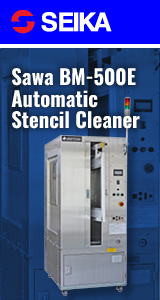|

|
|
| Ask the Experts | ||||||||
|
||||||||
|
December 13, 2024 - Updated August 21, 2013 - Originally Posted Extending Shelf Life for Jars of Solder PasteWe have a few unopened jars of solder paste that have just recently gone past the posted expiration date. The jars have been kept in refrigeration from the time of receipt at 5 +/- 3C. This is a no-clean paste with combination Sn62Pb36Ag2. We would like have extension of shelf life. How should we proceed? Y.S. |
||||||||
| Expert Panel Responses | ||||||||
|
You may want to consider storing the Paste at a lower temp. -40°c is optimum.
President Round Rock Consulting Following a successful 20 year career within world class OEMs and EMS providers including Honeywell, Bull Electronics, IBM, Celestica and Plexus, James founded Round Rock Consulting a business consultancy focused on supporting OEMs and EMS providers with product realization strategies.
The first course of action should be to talk with a technical resource at the manufacturer. It's highly likely that the paste is just fine, but a lot depends on the specific flux chemistry. The conservative approach would be to have the paste re-certified by the manufacturer and given a new expiration date. Another approach would be to do an in-house test to verify printing and soldering performance, and extend based on discussion with the manufacturer. My personal preference would be the latter approach, since it avoids the added risk of shipping it two ways.
Process Engineer Astronautics Fritz's career in electronics manufacturing has included diverse engineering roles including PWB fabrication, thick film print & fire, SMT and wave/selective solder process engineering, and electronics materials development and marketing. Fritz's educational background is in mechanical engineering with an emphasis on materials science. Design of Experiments (DoE) techniques have been an area of independent study. Fritz has published over a dozen papers at various industry conferences.
You will have to get in contact with the supplier/manufacturer of the solder paste and approach them with a request for expiration date extension. It is not unusual for them to address these types of requests. Depending on your specific case data (storage temperature, initia lexpiration date), the supplier can guarantee an extension.
Engineering and Operations Management Independent Consultant Georgian Simion is an independent consultant with 20+ years in electronics manufacturing engineering and operations.
Contact me at georgiansimion@yahoo.com. I would check with the manufacturer of the solder paste and find out just how conservative they might be with the stated expiration date. However, be ye warned! I have had experiences with solder paste (no-clean as a matter of fact) that was just 3 weeks past the expiration date and it turned to crap. Solder Ball City! You might do better to send it out for reclamation than taking a chance on it. And consider either buying it in smaller lots and/or scheduled release of the lots based on anticipated usage. Solder paste, like the mind, is a terrible thing to waste.
Principal Consultant ITM Consulting Mr. Zarrow has been involved with PCB assembly for more than thirty years. He is recognized for his expertise in troubleshooting SMT manufacturing and lead-free implementation. He has extensive hands-on experience with set-up and troubleshooting through-hole and SMT processes throughout the world.
Extending shelf life on solder paste may be a tricky thing to do. I would recommend the following test be conducted, solderability, solder balling, wetting characteristics, flux activity levels, slump, flux weight percentage,viscosity, percent metal, sphere size, plus others. I would also highly recommend getting in touch with the manufacturer for their inputs as to how to proceed, as perhaps they have a process to refresh the solder paste itself. Please keep in mind surface mount processes make solder joints quickly and in large volumes, so using bad, defective or expired solder paste to save buying new material could be very expensive as the expired solder paste is not a qualified material after its expiration date.
Vice President, Technical Director EPTAC Corporation At EPTAC Corporation, Mr. Lambert oversees content of course offerings, IPC Certification programs and provides customers with expert consultation in electronics manufacturing, including RoHS/WEEE and lead free issues. Leo is also the IPC General Chairman for the Assembly/Joining Process Committee.
Firstly ask the supplier their advice, alternatively carry out a simple solder balling test Cut 3 circles out of a business card using a hole punch (same as putting paper in lever arch folder) carefully hand print 3 circles of paste on a pwb resist area, make sure they are not touching pads or tracks (break off strips are great,if you have ceramic slides these are better) make sure the circles look smooth and not smudged. Put them through your standard reflow process, the circles should form 1 sphere, look through a low powered microscope to observe any satellite balls,if there are less than 10 satellites the activity is ok. If the material is also printable then it should be ok for a few weeks more. How ever check with your end customer as some will not allow you to use product out of shelf life and you may need to seek a concession from them to do this.
Global Product Champion Henkel Electronics Richard Boyle is a Global Product Champion at Henkel Electronics. He has over 25 years experience in the electronics assembly industry and is responsible for the global technical service of all of Henkel's solder materials.
Some paste manufacturers will re-certify material by running a sample through the same QA tests used during initial production i.e. solder ball, viscosity measurements, to determine if the material is still within specification. However there are several considerations:
Director of Product Management AIM Timothy O'Neill is the Director of Product Management for AIM Solder. AIM Solder is a leading global manufacturer of assembly materials for the electronics industry. Mr. O’Neill has 25 years of industry experience is a Certified IPC Specialist.
Mr. O’Neill’s responsibilities include developing product and technical information; he is a technical writer and presenter for industry trade publications and events and has been recognized as a Speaker of Distinction by the SMTA. Expiration date mentioned by manufacturer is with recommended storage condition. It is not recommended to use expire paste, though if you like to use check with manufacturer to send back to do evaluation and and possible remixing.
Supplier Quality Leader Ge Healthcare Subrat has 10 year of extensive experience in PCB assembly process optimizing for quality, process includes screen printing, wave, reflow. He has a copyright in stencil design published in Apex Expo2010 at Las Vegas US.
Reader Comment
Did I read James DiBurro's comment correctly? -40°C sounds awfully cold, and I've always read that storage beneath 32°F could cause problems with flux separation.
Leland Woodall, Keihin Carolina System Technology, LLC, USA
Reader Comment
If you purchase a small paste centrifuge, you eliminate the 1 or 2 hour wait for paste to come to room temp from refrigeration, you can print paste tested to TM 2.4.34 (viscosity), and if you print the slump pattern on pads on a rail and the agglomeration pattern onto the equivalent of a fiducial (the small center pad holds the agglomerated solder ball securely) and the wetting deposit is printed on a small square pad, you have essentially tested the paste for the full requirements of J-STD-005 ON EVERY SINGLE BOARD YOU EVER MANUFACTURE, automatically and free of any additional cost! Reader Comment
Richard Stadem's comments are on the money. I like that he refers to published codes rather than stating his own experience or opinion. One thing that should be considered is criticality of end assembly. You cannot use expired paste for mission critical assemblies.
Kartick Kudtarkar
Reader Comment
Richard Stadem's summary is the most comprehensive feedback I've ever seen on one page!
Mark Edwards, Hisco, Inc.
The pragmatist in me would also want to extend the life of most everything used in a PCB assembly operation. However, when one factors in the average cost of a 500 gram jar of paste ($50-125/jar, depending on alloy) and the amount of paste by volume used on the PCB, the solder cost is going to be very low versus the complete Bill of Materials (BOM). Factor in the extra time to extend the paste life and possible process/quality issues outlined above, and I would vote for working on more pressing assembly issues like first pass yield, SMT line uptime, change-over time, etc. Wouldn't you? |
||||||||
| Submit A Comment | ||||||||
|
Comments are reviewed prior to posting. You must include your full name to have your comments posted. We will not post your email address. |
|
Free Newsletter Subscription
Circuitnet is built for professionals who bear the responsibility of looking ahead, imagining the future, and preparing for it. Insert Your Email Address |
|

|










